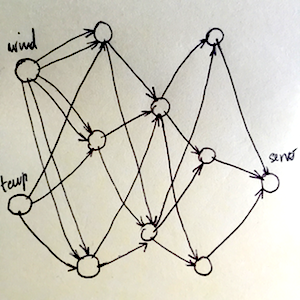zampino / Exnn
Programming Languages
Projects that are alternatives of or similar to Exnn
EXNN 
Evolutive Neural Networks framework à la G.Sher written in Elixir
Preliminary Notice
The work presented here is strongly influenced by the seminal book Handbook of Neuroevolution Through Erlang by Gene I.Sher, which is a vast source of inspiring concepts and thoughts on the topic.
On the other hand I tried to give the whole system a modular and configurable DSL-like approach exploiting Elixir macros and protocols, as well as OTP application components.
🚧 All this is quite still in progress 🚧
This library is in a very early stage, and it can at the moment only train a trivial xor function. With some love and time, it will see some improvements. Contributions are welcome, of course.
Docs
I am slowly building an ex_doc Documentation out of the code.
Usage Instructions
To use EXNN you will first mix EXNN as dependency and then
push EXNN.Supervisor module into the stack
of your application's supevised children.
Your main application file will also serve as configuration for customizing initial conditions of the system:
Configuration
defmodule MyApp do
use EXNN.Application
sensor :temp, MyApp.TempSensor, dim: 1
sensor :wind, MyApp.WindSensor, dim: 2
actuator :servo, MyApp.WindowServo
fitness MyApp.Fitness
initial_pattern [
sensor: [:temp, :wind],
neuron: {3, 2, 3},
actuator: [:servo]
]
def start(_, _) do
import Supervisor.Spec
children = [
supervisor(MyApp.MainSupervisor),
# ... all these beautiful supervised boys
supervisor(EXNN.Supervisor, [[config: __MODULE__]])
]
Supervisor.start_link children, [strategy: :one_for_one]
end
end
Note EXNN.Application is just a wrapper around Elixir/OTP Application module,
exposing the configuration DSL.
With sensor and actuator macros,
you can register sensor and actuator modules by name. For sensors
you have to specify the dimension of the signal vector.
With the fitness macro you register a fitness module wich will
compute in real time how much the present system is close to one (of the possible)
optimal configuration and topology.
initial_pattern decides the initial topology for your network, it's a
Keyword accepting the 3 keys above. You can only mention previously registered
sensors and actuators. The value for neuron key has to be a tuple denoting
the size of each neural layer you want your system to start with.
In the above example, the initial_pattern given would correspond to the digraph:
where all elements in a layer are connected to all vertices of the following.
Sensors
Your sensor module will use EXNN.Sensor. At its heart is an OTP genserver.
You have to implement the function sense/2 which is called when
EXNN.Trainer synchronizes all sensors in the system.
On the other hand, since it's a genserver registered with its module name, you can reach it from any external service providing sample data:
An optional state given to use accepts a keyword list to
feed initial conditions to the genserver state.
The state itself is a struct, named by your module's name.
defmodule MyApp.TempSensor do
use EXNN.Sensor, state: [outer_temp: 0]
def sense(state, _metadata) do
{state.outer_temp}
end
def handle_cast({:update_temp, value}, state) do
{:noreply, %{state | outer_temp: value}}
end
end
defmodule MyApp.WindSensor do
use EXNN.Sensor, state: [speed: 0, direction: 0 * :math.pi]
def sense(state, _meta) do
{state.speed, state.direction}
end
# ...some callbacks to update state...
end
sense/2 forwards the desired
signal to the front neuronal layer.
It takes the current state of the sensor and a tuple of scalar
values of the same length as the configured dimension.
Read more about sensors in the docs
Actuators
Using EXNN.Actuator in your modules you can setup a genserver
which reacts to signals coming from the terminal neural layer.
You have to implement an act/3 method which takes the current state,
a signal arrived from the neuronal layer and some metadata (more on
metadata later). act/3 can have the side-effects you desire
and must return the modified state.
The message passed to act/3 is a keyword list
[n_id: v] with a key n_id identifying the firing neuron,
and a scalar float value v.
defmodule MyApp.WindowServo do
use EXNN.Actuator, state: %{current: 0}
def act(state, message, _metadata) do
{:ok, new_val} = MyApp.WindowServo.Command.turn(message)
%{state | current: new_val}
end
end
Fitness
A Fitness module evaluates how the system is performing in real-time,
it's your responsibility to implement an eval/3 function taking the same
message passed to the actuator, the usual metadata and it's state.
The trainer will call eval in your module right after your actuators have changed the environment so that it can measure the effects actuators have introduced.
defmodule MyApp.Fitness do
use EXNN.Fitness, state: %{inner_temp: 0.0, outer_temp: 40.0}
def eval(state, _message, _metadata) do
diff = state.outer_temp - get_inner_temp
fitness = 1/(1 + :math.pow(diff, 2))
emit(fitness)
state
end
def get_inner_temp do
# ask inner temperature...
end
end
Examples
You can -- at present -- train a basic XOR problem by running:
mix test test/examples/xor_test.exs
Core Concepts
-
Sensors, Neuron and Actuators all live as GenServer processes registered with an identifier present in the underlying genome. They specialise an abstract
EXNN.NodeServerand implement aEXNN.Connectionprotocol to forward signals between nodes. -
Fitness modules intercept signals from the final neural layer and evaluates and emit a fitness rank to the
EXNN.Trainer.Syncwhich decides to mutate or revert the system to previous configuration. -
A mutation semigroup takes care of altering the genomes and injecting live (and concurrently) new weights/bias specifications into neuronal genserver processes. Each mutation has an inverse mutation, which restores a single node to its previous state. The trainer keeps track of the changes in a mutation history.
Future Plans
-
Instrumentation for learning times and logging.
-
Explorative search along mutation paths (see
EXNN.Trainer.Mutations) to split an individuum into two or more (mutation + mitosis). -
Handle sync among a population of nets through routing with fixed sensors and actuators.
-
Rewrite
EXNN.Trainer.Syncas a:gen_fsmwith states 'learning'/'production'. Switching to 'production' whenever fitness stably enters a tolerance neighborhood of 1.
References
- Gene.I.Sher, Handbook of Neuroevolution Through Erlang, 2013, Springer

